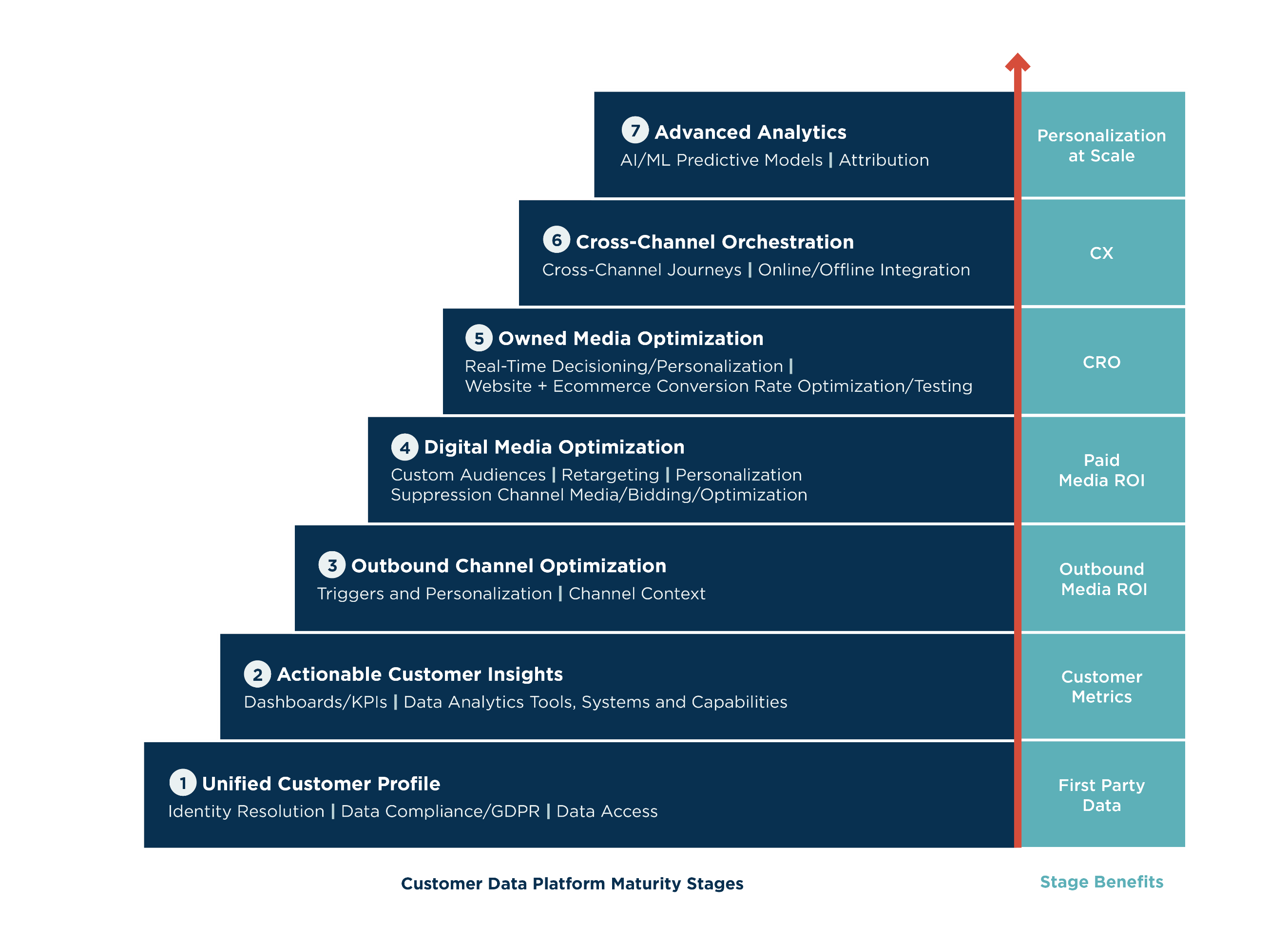Customer Data Maturity: a Seven-Stage Model
This article discusses the launch of a new seven-stage customer data maturity model. It reveals results from a new customer data excellence survey undertaken by London Research and BlueVenn. Find out how companies with customer data platforms are gaining tangible competitive advantages.

The ability to deliver data-driven brand experiences at all stages of the customer lifecycle is something that companies need to strive for. Under increasing pressure to prove their value, marketers spend significant amounts of time and effort sifting through data to identify those key moments of need, and to find the insights needed to act on them.
To provide marketers with more clarity and structure around what they are trying to achieve with their customer experience strategy, Digital Doughnut sister company London Research and BlueVenn have developed a seven-stage Customer Data Maturity Model as part of their customer data excellence research.
The maturity model, explained in detail by report co-author Andrew Campbell in a webinar now available on-demand, describes the capability that defines each stage, the functionality underpinning that capability, and the business benefits of having that capability in place. By focusing on business outcomes around customer experience delivery, rather than customer data platform functionality alone, the model enables a more practical and effective approach to technology deployment and marketing program development.
The Seven-Stage Customer Data Maturity Model

Source: London Research / BlueVenn Customer Data Excellence report
The model is a strategic planning tool that helps marketers define and prioritize their customer experience requirements, then methodically translate them into customer data requirements. It assists with auditing current capabilities and defining a future roadmap aligned to business goals, acting as a useful reference point. By using this maturity model, marketers ensure they adopt an integrated approach to leveraging, and ultimately monetizing, customer data by identifying and unlocking synergies across marketing programs.
Let’s quickly run through the seven stages included in the model:
Stage 1 – Unified Customer Profile
The first stage is the primary function of a CDP, namely establishing a persistent unified customer profile that is accessible to other systems. First-party data is the one thing you have that your competitors don’t, so a central hub that gives control over and access to your first-party data is essential. While the data hub supports compliance and data quality efforts by maintaining privacy and managing permissions, delivering highly personalized and timely experiences is the end game.
Stage 2 – Actionable Customer Insights
You’re now looking to analyze and mine the data you ingested, captured and stored during the first stage to access insights that help you better understand your customers. This can be accomplished via dashboards, reporting systems, queries, predictive models or other types of analysis.
Armed with the insights uncovered during this second stage, the next step is to activate that data and deliver a better, customer-centric experience. This can be done at differing levels of sophistication, as seen in Stages 3 to 6.
Stage 3 – Outbound Media Optimization
This stage involves triggering, personalizing and then pushing messages out to customers via owned media channels, such as email, direct mail or contact center. Tackling outbound channels first is the sensible approach as they’re an easy, proven way of driving engagement and response.
Stage 4 – Digital Media Optimization
You should be surfacing first-party data and defining tighter audience segments at this stage, using those insights to drive smarter targeting of off-site, paid digital media activities. With real-time decisioning and context in which content is delivered and consumed needing to be factored in, it’s a higher-order undertaking.
Stage 5 – Owned Media Optimization
This stage is all about supporting real-time personalized digital experiences in response to customer actions, particularly achieving a seamless integration between ecommerce and content marketing. An example is dynamic merchandising based on search terms, site navigation and conversion events.
This is one of the findings that emerged strongly through the research: 91% of CDP owners integrate their ecommerce stores with their main websites or content hubs, compared to only 75% of their peers.
Stage 6 – Cross-Channel Orchestration
This stage brings all the previous stages together to deliver a seamless, joined-up experience across online and offline channels.
Stage 7 – Advanced Analytics
The final stage brings a whole new level of sophistication, aiming to increase the breadth, scale, speed and precision of marketing programs. Personalization and segmentation are driven in real time, using machine learning and artificial intelligence, rather than just rules created by humans.
Stages 2 and 7 are all about data analysis and insights, while Stages 3 to 6 are very much about activation. Ultimately, this is what marketers want from their CDP: deeper insights and an improved ability to act on those insights and deliver a better experience as a result.
For more information on this customer data maturity model and how successful marketers are harnessing the power of CDPs, download the Customer Data Excellence report, published by London Research in partnership with BlueVenn.